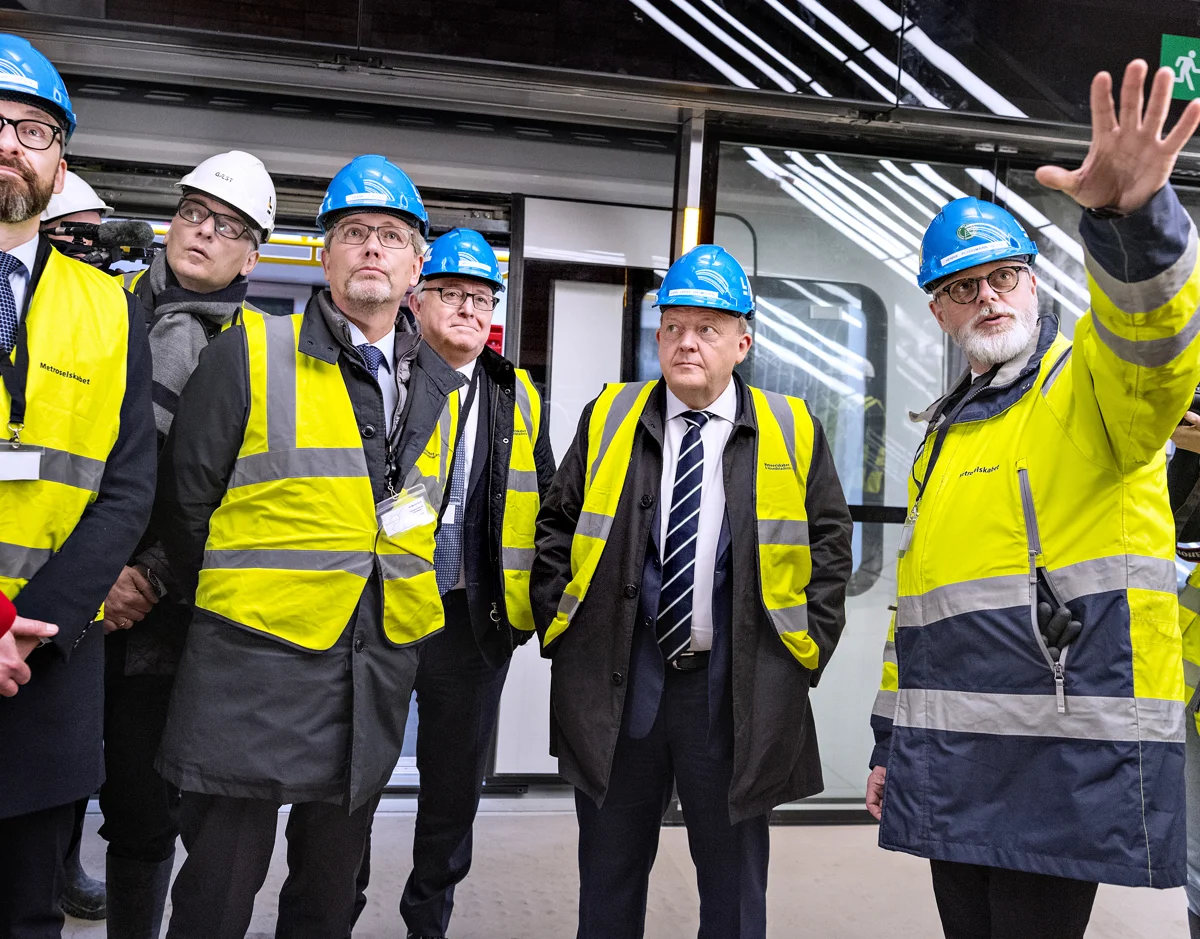
Metro's owners tested the M3 line's driverless trains
Today, a small delegation of Metroselskabet's owners had the opportunity to take a test ride on the capital's future M3 line, Cityringen (M3). The trip went from the Cityringen Control and Maintenance Center near Fisketorvet to the station at Enghave Plads and past the stations at Copenhagen Central Station and Rådhuspladsen towards the future metro station at Gammel Strand.
‘The M3 line is a huge win for all of us. The Metro means smooth traffic and is part of our shared vision to fight noise and air pollution and create a better environment. And it means the world to the expansion plans for Copenhagen,’ said Prime Minister Lars Løkke Rasmussen in a short speech before boarding the new, driverless train.
The Metro is popular and last year saw 2.5 per cent more passengers than expected - at a time when fewer people are using public transport in general.
While travelling on the city's future M3 metro line, the delegation passed the new Copenhagen Central Station, which with the M3 line will overtake Nørreport as the country's busiest station with 150,000 passengers a day. The opening of the M3 line will drive a significant positive development in public transport in the coming years.
An amazing gift is about to open for Copenhageners and everyone who visits our beautiful city. We will get our city back with lovely green spaces instead of building plots behind fences - and the M3 line will provide a whole new way of travelling in the city and bring us closer together throughout Copenhagen.
The facts
The City Ring is 15.5 kilometres long (two tunnel tubes all the way around the ring) and has 17 underground stations connecting Østerbro, Nørrebro, Frederiksberg, Vesterbro and M3 line.
The M3 line has left its mark on the capital for almost 10 years. The M3 line Act was passed by the Danish Parliament in 2007. This was followed by public consultations and an EIA process. Several kilometres of supply lines and pipes (sewer, telephone, electricity, gas, etc.) were moved around in the years 2008-2010 to make room for the construction of the metro stations under the city. In the period 2008-2011, the Museum of Copenhagen also coordinated the largest archaeological excavation project in the capital. In 2011, the actual construction work began. The M3 line is expected to open during the summer.
The current Metro had almost 65 million passengers in 2018, corresponding to a passenger growth of 1.2 million passengers or 2.5 per cent. Once the M3 line is open, the number of journeys on the Metro is expected to reach 122 million in 2020.
With the opening of the M3 line (M3), the Metro will double its passenger numbers in a few years, which last year totalled almost 65 million passengers. Approximately six months after the opening of the M3 line, the Nordhavn line is expected to open its doors to passengers. The Nordhavn Line (M4) will initially add two extra stations to the metro system, and in 2024, the five stations of the Sydhavn Metro will be connected to the M4.
‘When the M3 line, Nordhavn Metro and Sydhavn Metro are completed, we will have a stronger and more efficient public transport network in the capital that will be an even better alternative to the car in the most densely populated areas. It will help to reduce congestion, limit air pollution, and the city will be better able to accommodate the high demand for more housing. The construction of the Metro is a really big win for the capital - both for travellers who live in the city and for those who come to visit’, says Minister of Transport, Building and Housing Ole Birk Olesen.
In Frederiksberg, the M3 line will mean that Frederiksberg station will become the country's fifth largest station in terms of passenger numbers. The mayor is pleased that the M3 line will provide the municipality with new stations and connections to the rest of the capital.
‘In Frederiksberg, we're excited about the huge boost the M3 line will give to public transport throughout the capital. It will be a big and festive day when we finally inaugurate the M3 line this summer and a significant milestone in our efforts to create sustainable and user-friendly transport. At the same time, we must also look ahead and work for even more Metro in the future,’ says Jørgen Glenthøj, Mayor of Frederiksberg Municipality.
Today's test run marks the approaching opening of the M3 line. In April, an important milestone in the project will be reached and the test runs are then expected to be optimised to resemble regular metro operations. An expected opening date is expected to be announced after The Company has assessed whether the planned milestones in late March and April have been achieved.
However, the opening date can only be confirmed once the independent assessor has assessed that safety is in order and the Danish Transport, Construction and Housing Authority has granted the final authorisation to carry passengers. This authorisation will only be available shortly before the actual opening date.